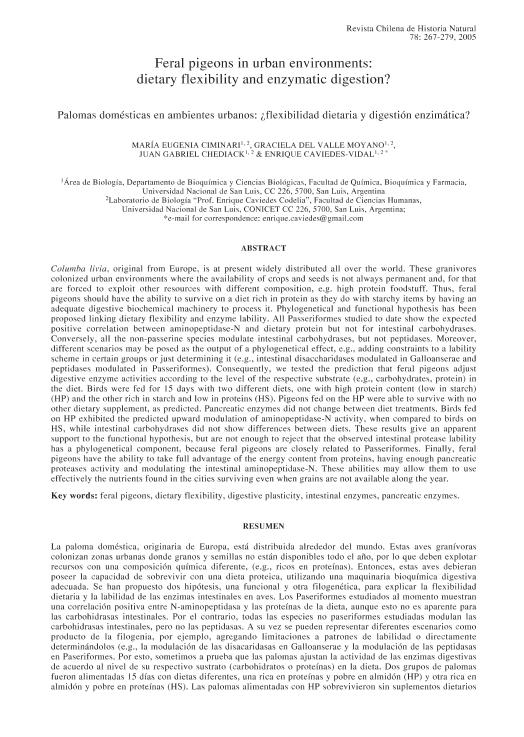Artículo
Columba livia, original from Europe, is at present widely distributed all over the world. These granivores colonized urban environments where the availability of crops and seeds is not always permanent and, for that are forced to exploit other resources with different composition, e.g. high protein foodstuff. Thus, feral pigeons should have the ability to survive on a diet rich in protein as they do with starchy items by having an adequate digestive biochemical machinery to process it. Phylogenetical and functional hypothesis has been proposed linking dietary flexibility and enzyme lability. All Passeriformes studied to date show the expected positive correlation between aminopeptidase-N and dietary protein but not for intestinal carbohydrases. Conversely, all the non-passerine species modulate intestinal carbohydrases, but not peptidases. Moreover, different scenarios may be posed as the output of a phylogenetical effect, e.g., adding constraints to a lability scheme in certain groups or just determining it (e.g., intestinal disaccharidases modulated in Galloanserae and peptidases modulated in Passeriformes). Consequently, we tested the prediction that feral pigeons adjust digestive enzyme activities according to the level of the respective substrate (e.g., carbohydrates, protein) in the diet. Birds were fed for 15 days with two different diets, one with high protein content (low in starch) (HP) and the other rich in starch and low in proteins (HS). Pigeons fed on the HP were able to survive with no other dietary supplement, as predicted. Pancreatic enzymes did not change between diet treatments. Birds fed on HP exhibited the predicted upward modulation of aminopeptidase-N activity, when compared to birds on HS, while intestinal carbohydrases did not show differences between diets. These results give an apparent support to the functional hypothesis, but are not enough to reject that the observed intestinal protease lability has a phylogenetical component, because feral pigeons are closely related to Passeriformes. Finally, feral pigeons have the ability to take full advantage of the energy content from proteins, having enough pancreatic proteases activity and modulating the intestinal aminopeptidase-N. These abilities may allow them to use effectively the nutrients found in the cities surviving even when grains are not available along the year. La paloma doméstica, originaria de Europa, está distribuida alrededor del mundo. Estas aves granívoras colonizan zonas urbanas donde granos y semillas no están disponibles todo el año, por lo que deben explotar recursos con una composición química diferente, (e.g., ricos en proteínas). Entonces, estas aves debieran poseer la capacidad de sobrevivir con una dieta proteica, utilizando una maquinaria bioquímica digestiva adecuada. Se han propuesto dos hipótesis, una funcional y otra filogenética, para explicar la flexibilidad dietaria y la labilidad de las enzimas intestinales en aves. Los Paseriformes estudiados al momento muestran una correlación positiva entre N-aminopeptidasa y las proteínas de la dieta, aunque esto no es aparente para las carbohidrasas intestinales. Por el contrario, todas las especies no-paseriformes estudiadas modulan las carbohidrasas intestinales, pero no las peptidasas. A su vez se pueden representar diferentes escenarios como producto de la filogenia, por ejemplo, agregando limitaciones a patrones de labilidad o directamente determinándolos (e.g., la modulación de las disacaridasas en Galloanserae y la modulación de las peptidasas en Paseriformes. Por esto, sometimos a prueba que las palomas ajustan la actividad de las enzimas digestivas de acuerdo al nivel de su respectivo sustrato (carbohidratos o proteínas) en la dieta. Dos grupos de palomas fueron alimentadas 15 días con dietas diferentes, una rica en proteínas y pobre en almidón (HP) y otra rica en almidón y pobre en proteínas (HS). Las palomas alimentadas con HP sobrevivieron sin suplementos dietarios adicionales. Las enzimas pancreáticas fueron iguales entre tratamientos. Las palomas alimentadas con HP exhibieron una actividad de N-aminopeptidasa mayor que la de HS, mientras que las carbohidrasas fueron iguales entre dietas. Estos resultados dan soporte a la hipótesis funcional, pero también, son insuficientes para rechazar que la labilidad de la proteasa intestinal constituye un efecto filogenético, ya que estas aves constituyen un grupo cercano a los Passeriformes. En síntesis, las palomas poseen la capacidad de utilizar las proteínas debido a que poseen una actividad proteásica pancreática adecuada y modulan la N-aminopeptidasa. Estas características permiten que las palomas domésticas aprovechen efectivamente alimentos que ofrecen las ciudades y sobrevivan aun cuando la disponibilidad de granos sea escasa.
Feral pigeons in urban environments: Dietary flexibility and enzymatic digestion?
Título:
Palomas domésticas en ambientes urbanos: ¿Flexibilidad dietaria y digestión enzimática?
Ciminari, María Eugenia; del Valle Moyano, Graciela; Chediack, Juan Gabriel ; Caviedes Vidal, Enrique Juan Raul
; Caviedes Vidal, Enrique Juan Raul
 ; Caviedes Vidal, Enrique Juan Raul
; Caviedes Vidal, Enrique Juan Raul
Fecha de publicación:
12/2005
Editorial:
Sociedad de Biología de Chile
Revista:
Revista Chilena de Historia Natural
ISSN:
0716-078X
e-ISSN:
0717-6317
Idioma:
Inglés
Tipo de recurso:
Artículo publicado
Clasificación temática:
Resumen
Archivos asociados
Licencia
Identificadores
Colecciones
Articulos(CCT - SAN LUIS)
Articulos de CTRO.CIENTIFICO TECNOL.CONICET - SAN LUIS
Articulos de CTRO.CIENTIFICO TECNOL.CONICET - SAN LUIS
Articulos(IMIBIO-SL)
Articulos de INST. MULTIDICIPLINARIO DE INV. BIO. DE SAN LUIS
Articulos de INST. MULTIDICIPLINARIO DE INV. BIO. DE SAN LUIS
Citación
Ciminari, María Eugenia; del Valle Moyano, Graciela; Chediack, Juan Gabriel; Caviedes Vidal, Enrique Juan Raul; Feral pigeons in urban environments: Dietary flexibility and enzymatic digestion?; Sociedad de Biología de Chile; Revista Chilena de Historia Natural; 78; 2; 12-2005; 267-279
Compartir
Altmétricas



